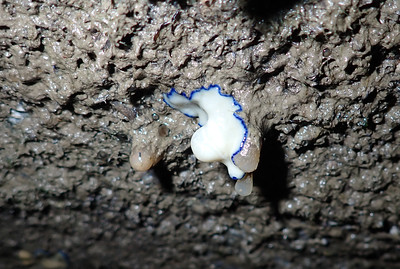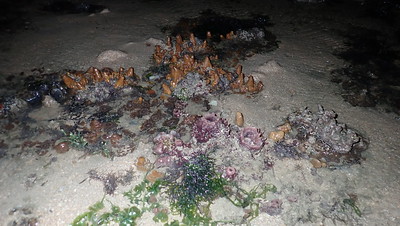Today, we didn't see the usual diversity that we have come to expect. And none of us saw Biscuit sea stars, which are usually abundant. On the plus side, we didn't notice much bleaching.
Like most of our northern shores, the stars of this shore are the echinoderms. Unfortunately, we didn't come across the usual wide variety of sea stars. Only a few Knobbly sea stars, and I saw an Eight-armed luidia sand star. The rest also saw other kinds of sand stars. But none of us saw any Biscuit sea stars! These are usually so abundant, so it is worrying to not come across any. On the positive side, there were many large White sea urchins.
I saw one Black long sea cumber, more often seen in reefy Southern shores. But the usual common 'northern 'sea cucumbers were also seen: Thorny sea cucumber, Pink warty sea cucumber (though these two not is such huge numbers as on Changi). Also some Orange sea cucumbers, some medium sized Garlic bread sea cucumbers, and many Ball sea cucumbers above ground.
We are concerned about mass coral bleaching on our shores going on right now. There were a few small patches of Zebra coral near the mid water mark, all were not bleaching. Unfortunately, the tide wasn't low enough to go the area where I last saw some Boulder pore corals. But Kok Sheng saw some hard corals and they seemed alright.
It was nice to see a variety of cowries on this shore. The usual favourites like Onyx cowrie and Miliaris cowrie. But also less often seen: Graceful cowries, a pair of small ones wedged in a crevice with an Ovum cowrie in between them.
I spent more time today on the high shore, checking out the huge boulders. I am amazed to see so many tiny Blue-dot margined flatworms ferociously feeding on Yellow clustered bead ascidians.
There were some sponges but not as many or as wide a variety as in the past. I also didn't see any large sea fans.
A large section of the mid-shore was densely covered with empty shells of Horse mussels. I looked and couldn't find any living ones. On our last survey here in Jul 2019 I only saw a few empty shells. I am relieved they have not taken over the shore at Pulau Sekudu like they did at one part of Changi, which I first noticed in Feb 2019.
The seagrasses are doing well here. There are lush green clean (no epiphytes) growths of Spoon seagrass (both small and large leaf blades). There were many patches of Fern seagrass and Needle seagrass. But we didn't see any dugong feeding trails. Serrated ribbon seagrass seems to have spread to a larger area, now found in sparse patches from the mid-water mark to the low tide line. Compared to what I saw in July 2019 and in Jun 2018.
I saw only one clump of Tape seagrass. It had leaves that were only about 50cm long. But Kok Sheng saw a clump with longer leaves. On our last survey in July 2019, the leaves were at least 1m long, the longest I've seen in recent years.
The sand pile that forms a 'spine' on Pulau Sekudu has grown a lot taller. Today, we also couldn't walk around the arm of the lagoon. The tide wasn't as low as our usual preferred height, but has the elevation on the arm of the lagoon also changed?
Sadly, I came across two small fish traps in the big lagoon near the edge of the intertidal flats. There were about 15 small filefishes and other fishes caught in the traps. I released them. On our last survey in Jul 2019, we also saw 3 fish traps here.
Pulau Sekudu is off limits since 2007 and requires special permission from NParks. Thanks to NParks for permission and support to do these predawn low spring tide surveys of Chek Jawa. Thanks also to Chay Hoon for making all the transport arrangements. And the team for helping to cover as much ground as we can during the narrow low tide window. Thank you!
What is the fate of Pulau Sekudu?
Chek Jawa and Pulau Sekudu may be affected by the 2030 landuse plan by the Ministry of National Development. The plan includes plans for a road link (black line) from the mainland jumping off at Punggol, crossing to Pulau Ubin through Chek Jawa to jump off to Pulau Tekong before circling back to the mainland on Changi East. Proposed reclamation (in yellow) will bury Pasir Ris shores, Pulau Sekudu and Chek Jawa as well as a large amount of shore at Changi Beach. I feel it is thus important to update our understanding of what is going on in the field at these sites including Chek Jawa and Pulau Sekudu.
The Singapore Blue Plan 2018
Among the Proposed Areas for Immediate Conservation Priority, the Singapore Blue Plan 2018 proposes that the intertidal and subtidal marine areas of Pulau Ubin to be designated Marine Reserve.
The proposed area would include Tanjung Chek Jawa, the largest known intertidal area in northern Singapore. Considered one of the richest in Singapore, Chek Jawa comprises many adjacent ecosystems: coastal hill forest, mangrove areas, rocky shores, seagrass meadows, coral communities, and sandy areas. Chek Jawa remains an icon of celebration and hope for many Singaporeans since its reprieve from reclamation in 2001.
DOWNLOAD the Plan, SUPPORT the Plan! More on the Singapore Blue Plan 2018 site.
Posts by others on this survey
Loh Kok Sheng
Marcus Ng
Jianlin Liu
Toh Chay Hoon
Dayna Cheah













